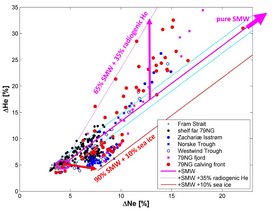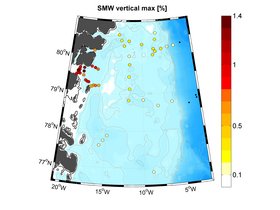Submarine Meltwater from Nioghalvfjerdsbræ (79 North Glacier), Northeast Greenland


The Greenland Ice Sheet faces accelerated melting under warming climate conditions. This also affects the largest marine-terminating outlet glacier of the Northeast Greenland Ice Stream, the Nioghalvfjerdsbræ (79 North Glacier, 79NG). Melting there occurs at the surface and, moreover, by warm Atlantic Water spilling into the cavity beneath its 80 km long floating ice tongue. However, freshwater from submarine melting is hardly distinguishable from other freshwater sources by salinity alone.
To identify and to quantify the distribution of submarine meltwater (SMW) on the Northeast Greenland Shelf, we use helium (He) and neon (Ne) observations obtained directly at the calving front of the 79NG, on the Northeast Greenland Shelf, and in Fram Strait during an expedition aboard R/V POLARSTERN in summer 2016. These tracers uniquely identify SMW and allow quantifying its fraction in ocean water.
SMW from the 79NG is present on the entire Northeast Greenland Shelf but dilutes from 1.8% at the calving front to nonsignificant in Fram Strait. The SMW formation rate of the 79NG was estimated to be 14.5 ± 2.3 Gt per year, equivalent to a meltrate of 8.6 ± 1.4 m per year. A surplus of He compared to Ne in the SMW indicates a substantial addition of radiogenic He from the bedrock, the 79NG is resting on before it slides into the ocean. A surplus of Ne compared to He in the upper 100 meters observed on most of the shelf region is attributed to noble gas fractionation during sea ice formation. Combining this Ne excess with the ventilation time on the shelf of 1.5 years yields a mean sea ice formation rate of 4 m per year.
The interaction between SMW and Greenland glacier mass balance remains poorly understood and is difficult to model. Our noble gas data illustrate the active glacier-ocean interaction in case of the 79NG. He and Ne observations provide robust results for SMW formation rates, independently from and compatible with other methods. He and Ne observations allow to quantify the formation and to elucidate the fate of SMW, its circulation and further mixing with ambient water masses. To validate coupled glacier-ocean models, tracers as He and Ne could be incorporated for SMW, and modeled distributions compared with observations.
This work has been recently published at Huhn, O., Rhein, M., Kanzow, T., Schaffer, J., & Sültenfuß, J. (2021). Submarine meltwater from Nioghalvfjerdsbræ (79 North Glacier), Northeast Greenland. Journal of Geophysical Research: Oceans, 126, e2021JC017224. https://doi.org/10.1029/2021JC017224 by the Labsea Melt II project.
